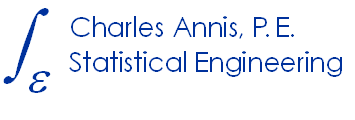How to get, install, and use the mh1823 POD Software,
… for Macintosh users
(Please read all the instructions before continuing.)
First, get things ready:
Since the mh1823 POD algorithms use R for all data manipulation, statistical analysis, and graphics …
- Download and install R from https://www.r-project.org
- Download and install XQuartz-2.7.9.dmg that R uses for graphics on Macs (https://www.xquartz.org)
- Download and install javaforosx.dmg for Java support of R packages (Google it)
- Next, send me an e-mail:
(Cha@Ga7Arles.@kUtNpAnnisGHPQE@StatisticalaRdZ-Engineering7eAa48.cAPKzjom).
Be sure to put mh1823 POD in the subject line or I may miss your request. (I try to respond as soon as the request arrives.)
The rest is easy:
- Using the Finder, Documents menu, create a new folder called R-Projects.
- Rename the attached file from ngzip to .zip, and unzip it in your R-Projects folder.
That will create a folder called “mh1823 x.x.x STANDARD. DO NOT UNZIP the zip file or the tarball within. R will do that.
- Move the mh1823_x.x.x.tar.gz tarball to the R-Projects folder.
- Start R from the Macintosh Finder, Applications menu, invoke R.
- … from within R, download and install packages tcltk, tcltk2, survival, xlsx from a CRAN (Comprehensive R Archive Network) mirror near you.
To do that, choose the Packages & Data menu in R and then the Package installer. This will open a window showing the Packages Repository.
- Choose CRAN (binaries) as the source, Get the list of packages, and install tcltk, tcltk2, survival, xlsx using the blue “Install” button. Be sure to check the Install Dependencies box.
- …. from within R, from the Packages AND Data menu in R and then the Package installer, now point to the Local Source Package and install mh1823_x.x.x
Now you have everything set up. To run a package you must first load it. From the R console, load mh1823.
- To do that, choose Packages & Data, Package Manager and check the box for mh1823, and after it is loaded the mh1823 stand-alone TclTk menu will appear. If it hides, you can always find it with the XQuartz button.
- Also, it’s a good idea to close the Packages window when you’ve finished starting mh1823, and always keep the R console visible because that’s where the program tells you what’s going on.
Now you are ready to work through the Example Datasets. (Please do that.)
I am very (very) new to Mac (I used a 6 year old borrowed laptop to check this out) so I would appreciate any feedback, positive or negative, concerning the Mac setup. Mac user tips would be useful too, if you have any.
Note on firewalls:
Downloading software on the company computer may run afoul of enterprise policy. One remedy is to install R and the mh1823 POD package on a 1 gig memory stick. (It takes about 1/4 Gig total.) Then you can analyze NDE data, and produce POD vs. size curves, on any computer – plug in the stick and you’re good to go. All the analysis, results and plots will be on the stick.

